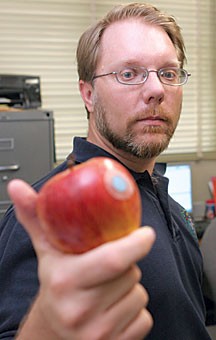A UA professor could help the agriculture industry save millions of dollars with his new invention: a sticker that can determine the ripeness of fruits and vegetables.
The sticker, known as RediRipe, changes color from white to blue as ethylene gas emits from the fruits or vegetables as they ripen, said Mark Riley, an associate professor of agriculture and biosystems engineering who invented the sticker.
The bluer the sticker, the more ethylene gas has passed through it. A dark blue sticker indicates that the fruit has begun to spoil, Riley said.
“”That old saying ‘one bad apple spoils the bunch,’ it’s actually true,”” Riley said. “”If you have one apple releasing large amounts of ethylene gas, as apples do when they are spoiled, then it can speed up how quickly the apples around them spoil.””
The RediRipe sticker was developed ideally for growers and packers of fruits and vegetables to tell them when produce should be picked and sold, but it can also be used by consumers, Riley said.
“”There’s a lot of fruit out there that’s wasted,”” Riley said. “”With apples, it’s something like $300 million a year in revenue that’s lost from either picked at the wrong time or spoiling.””
Over the next few months the UA will work with growers and packers to test the sticker, and in about 18 months consumers should see the sticker on fruits and vegetables in grocery stores. Eventually, consumers will be able to buy the sticker themselves, Riley said.
“”Our goal is to make the final price to either a consumer or grower just a couple of pennies,”” Riley said. “”People will be able to buy them in stores kind of like kids’ stickers on a sheet.There are some things we need to improve and that’s what were working on in the next few months,”” Riley said.
Developing a product like RediRipe for growers and packers instead of for the average consumer proved to be an obstacle because the variables of temperature, rain and environment in a field are vastly different from that of a kitchen or someone’s home, which stay dry and at a much more constant temperature, Riley said.
The majority of testing of the RediRipe sticker has been done in labs at the UA, but field trials have also been conducted to simulate the environment in which fruits and vegetables grow, Riley said.
Riley said it took four years to develop the RediRipe sticker, with assistance from a few undergraduates, one graduate student and a lab technician.
The only funding received for the development of the RediRipe sticker was contributed by the Washington Tree Fruit Research Commission and the USDA’s Cooperative State Research, Education and Extension Service, Riley said.
Currently a patent is pending for the process of chemical reaction that the sticker performs, and a trademark is pending for the RediRipe name, said Stephen Oneil, manager of special projects and outreach services for the UA office of technology transfer.
The UA currently owns hundreds of patents and copyrights which brought in roughly $370,000 in license revenue in 2000 and roughly $1.18 million in license revenue in the 2005 fiscal year, Oneil said.
“”The revenue that the university makes in technology transfer is an indicator of how well university inventions are getting out into the market and making an impact, so we obviously would like to see that number increase,”” Oneil said.
Usually people think of medicines and devices as inventions from the university that make it to the market place, but the university develops many different types of technologies each year, Oneil said.
“”We think RediRipe is a very interesting example of an innovation from the university both for its inherent benefit for society and for the fact that it’s a little different from what people usually think of as technology transfer from the university,”” Oneil said. “”We’re just delighted that it’s getting some profile and getting out there.””
RediRipe will work with about half the fruits and vegetables normally found in a grocery store, including apples, peaches, pears, avocados, tomatoes, some melons and cantaloupes, Riley said.
“”Bananas produce a lot of ethylene, but the ethylene doesn’t have a lot to do with the ripeness of bananas,”” Riley said. “”So it won’t work on bananas or leafy vegetables and berries.””
Riley said he is still working to make the color change of the sticker more stable and noticeable.









